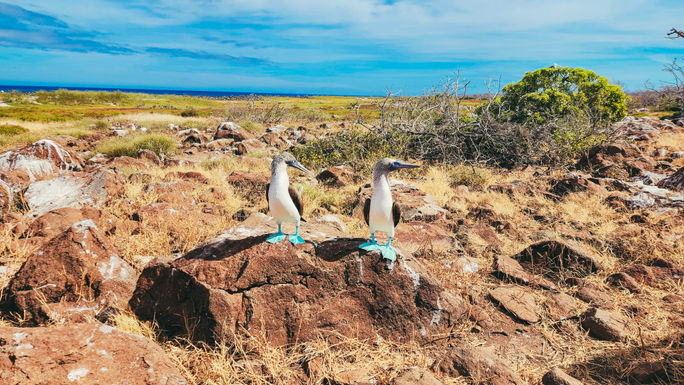Located 1,000 kilometres off the coast of Ecuador, the Galápagos Islands are a bucket-list dream for many travellers.
A UNESCO World Heritage Site, the Galápagos Islands are a volcanic archipelago of 13 main islands and over 100 islets. The islands feature not only unique wildlife, but also diverse landscapes, including beaches, highlands, and lava fields.
Whether your clients are nature enthusiasts, adventure seekers, or simply curious about this much talked about destination, here’s a list of frequently asked questions to help guide their travel planning:

Wildlife during a Galapagos adventure. (Photo Credit: Terika L. Haynes)
Q: What makes the Galápagos Islands a biodiversity hotspot?
A: Known for its extraordinary wildlife, pristine landscapes, and the inspiration behind Darwin’s theory of evolution, the Galápagos Islands are home to a variety of species that are endemic, such as giant tortoises, blue-footed boobies, marine iguanas, and Darwin’s finches, whose variations in beak shapes played a key role in the development of the theory of natural selection.
Q: When is the best time to visit?
A: The islands offer unique experiences year-round, but December to May is ideal for snorkelling, swimming, and enjoying pleasant weather. June to November offers cooler weather and excellent wildlife viewing opportunities, such as whale and dolphin watching.
Q: What can travellers expect from Galápagos cuisine?
A: Fresh seafood is at the heart of Galápagos cuisine, distinguished by dishes like ceviche, grilled fish, and encocados (seafood in coconut sauce). El Pez Brujo, a prized local fish known for its firm, white flesh and mild flavour, is often grilled or baked to perfection, making it a must-try for seafood lovers. Another highlight is the local lobster, particularly abundant between September and December.
Visitors should also try locally grown Galápagos coffee, known for its rich flavour. Popular dining spots include Los Kioskos in Puerto Ayora for casual bites, La Panga for seafood with a local twist, and Islander for a relaxed setting with great coffee.

A diver is surrounded by fish off the Galapagos. (photo via Ecuador Tourism Board) (Photo Credit: (photo via Ecuador Tourism Board))
Q: Can visitors experience sustainable tourism in the Galápagos?
A: Sustainable tourism is a high priority in the delicate ecosystem of the Galápagos, with eco-lodges, certified tour operators, and strict environmental guidelines in place. Visitors can stay at eco-friendly accommodations like Finch Bay Eco Hotel, enjoy carbon-neutral travel options, and participate in wildlife-friendly tours that help protect the islands. These efforts ensure a responsible travel experience while preserving the natural beauty of the Galápagos.
Q: How does Ecuador protect the fragile ecosystems of the Galápagos?
A: Ecuador enforces strict regulations for tourism, including limiting the number of visitors, designating no-touch zones, and requiring licensed guides for all tours. The Galápagos National Park covers 97% of the land, while the surrounding waters are part of the Galápagos Marine Reserve.
Additionally, the newly established Hermandad Marine Reserve extends protection for marine biodiversity, ensuring the islands and their ecosystems are preserved for future generations.

